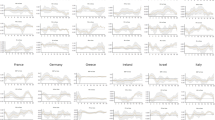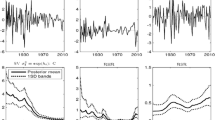Abstract
Relying on the methodology of deviation cycle dynamics, we analyze whether the association of wealth inequality measures and the real, financial and housing cycle are nationally idiosyncratic. Making use of recently available long time series for France, the United Kingdom (U.K.) and the United States (U.S.), we establish evidence in support of stock market returns co-moving with wealth concentration. However, this holds only for time series of the two studied Anglo-Saxon economies. The top one percent wealth share dynamics evolve procyclically across the housing, real and financial cycle dimension for the U.S. only. Cyclical growth of the French national product coincides with a falling wealth share of top and bottom percentiles and an increasing share of the middle class. No corresponding relationship was found for the U.S. and the U.K. Vector autoregressions (VAR) with single-shock identification confirm our frequency domain results. In the VAR(X) estimates, controlling for the subprime mortgage crisis statistically matters for the wealth concentration response to shocks in housing and stock prices and gross domestic product for the U.S. A control for the European sovereign debt crisis in the case of France is statistically insignificant.




Similar content being viewed by others
Notes
As the quantitative analysis for the U.S. middle 40 percent and bottom 50 percent wealth shares did not generate statistically significant results at any conventional level of significance, we refrain from displaying corresponding series and estimates.
To warrant the ranges of series reported in notes to Table 1 required the imputation of missing values, which we tried to keep to a minimum; see also notes to Figs. 1 and 2. Nevertheless the findings are qualitatively in line with (the less precise) estimates that fully abstract from imputing missing values. Corresponding results are available on request from the authors.
Note, for a shorter subperiod (starting 1963) the analysis reveals a medium strength positive correlation between the French wealth share of the middle 40 percent (0.33), and moderately strong negative correlations with the top 10 percent (-0.49) and top one percent (-0.49) wealth shares with all correlations significant at the five percent level. The shorter subperiod likely puts more importance to the most recent housing crash which possibly is driving this negative correlation. Wealthier individuals would have lost a higher portion of wealth compared to middle class individuals. Detailed results are available on request from the authors.
As these series are not in levels, our interpretation is restricted to relative effect sizes of IRFs and the vertical axes is not labeled as is common practice in the literature (e.g., Bernanke et al.2005, pp. 408–411).
References
Alvaredo, F., Chancel, L., Piketty, T., Saez, E., Zucman, G. (2017). Global inequality dynamics: New findings from WID world. American Economic Review, 107 (5), 404–409.
Artis, M., Marcellino, M., Proietti, T. (2004). Dating business cycles: A methodological contribution with an application to the euro area. Oxford Bulletin of Economics and Statistics, 66(4), 537–565.
Baxter, M., & King, R.G. (1999). Measuring business cycles:, Approximate band-pass filters for economic time series. Review of Economics and Statistics, 81(4), 575–593.
Bernanke, B. S., Boivin, J., Eliasz, P. (2005). Measuring the effects of monetary policy: A factor-augmented vector autoregressive (FAVAR) approach. Quarterly Journal of Economics, 120(1), 387–422.
Cagetti, M., & De Nardi, M. (2008). Wealth inequality: Data and models. Macroeconomic Dynamics, 12(s2), 285–313.
Christiano, L.J., Eichenbaum, M., Evans, C.L. (1999). Monetary policy shocks: What have we learned and to what end? In Woodford, M., & Taylor, J. (Eds.) Handbook of Macroeconomics, 1(A), North Holland: Amsterdam, The Netherlands, 66–147.
Christiano, L. J., & Fitzgerald, T.J. (2003). The band pass filter. International Economic Review, 44(2), 435–465.
Fagereng, A., Guiso, L., Malacrino, D., Pistaferri, L. (2016). Heterogeneity and persistence in returns to wealth. NBER Working Paper, 22822, https://www.nber.org/papers/w22822.pdf.
Hodrick, R. J., & Prescott, E.C. (1997). Postwar U.S. business cycles:, An empirical investigation. Journal of Money, Credit and Banking, 29(1), 1–16.
Igan, D., & Loungani, P. (2012). Global housing cycles. International Monetary Fund (IMF) Working Paper 2012/217, https://doi.org/10.5089/9781475505672.001.
Knoll, K., Schularick, M., Steger, T. (2017). No price like home: Global house prices, 1870-2012. American Economic Review, 107(2), 331–353. dataset: https://assets.aeaweb.org/assets/production/files/3141.zip.
Kohl, S. (2019). The political economy of homeownership: a comparative analysis of homeownership ideology through party manifestos. forthcoming in Socio-Economic Review; ahead of print access: https://doi.org/10.1093/ser/mwy030.
Komlos, J. (2019). Reaganomics: A historical watershed moment on the road to Trumpism. forthcoming in The Economists’ Voice; ahead of print access: https://www.degruyter.com/printahead/j/ev.
Kuhn, M., Schularick, M., Steins, U.I. (2017). Income and wealth inequality in America, 1949-2016. CESifo Working Paper, 6608, http://www.cesifo-group.de/DocDL/cesifo1_wp6608.pdf.
Milanovic, B. (2014). The return of “patrimonial capitalism”: A review of Thomas Piketty’s Capital in the Twenty-First Century. Journal of Economic Literature, 52 (2), 519–534.
Multpl. (2018). Inflation adjusted S&P 500. Open source economic data provider, original source: Standard & Poor’s (https://www.standardandpoors.com); dataset: http://www.multpl.com/inflation-adjusted-s-p-500.
Organisation for Economic Co-operation and Development. (2008). Growing unequal? Income distribution and poverty in OECD countries. Organisation for Economic Co-operation and Development (OECD): Paris, France.
Organisation for Economic Co-operation and Development. (2017). Main economic indicators: Finance (edition 2017/04). Organisation for Economic Co-operation and Development (OECD): Paris, France; dataset: https://doi.org/10.1787/mei-data-en.
Piketty, T. (2014). Capital in the twenty-first century. Cambridge: Harvard University Press.
Piketty, T. (2014). Capital is back: Wealth-income ratios in rich countries 1700–2010. Quarterly Journal of Economics, 129(3), 1255–1310.
Saez, E., & Zucman, G. (2016). Wealth inequality in the United States since 1913: Evidence from capitalized income tax data. Quarterly Journal of Economics, 131(2), 519–578.
Schüler, Y.S., Hiebert, P.P., Peltonen, T.A. (2017). Coherent financial cycles for G-7 countries: Why extending credit can be an asset. European Systemic Risk Board (ESRB) Working Paper, 43, https://www.esrb.europa.eu//pub/pdf/wp/esrbwp43.en.pdf.
World Inequality Database. (2018). World inequality database; dataset: https://wid.world/data/.
Acknowledgments
We thank Gregor von Schweinitz, the editor, and two anonymous referees for very helpful comments and suggestions that markedly improved our paper.
Author information
Authors and Affiliations
Corresponding author
Additional information
Publisher’s Note
Springer Nature remains neutral with regard to jurisdictional claims in published maps and institutional affiliations.
Electronic supplementary material
Below is the link to the electronic supplementary material.
Rights and permissions
About this article
Cite this article
Bryant, C., Süssmuth, B. Is the Relationship of Wealth Inequality with the Real, Financial and Housing Cycle Country-Specific?. Atl Econ J 47, 323–341 (2019). https://doi.org/10.1007/s11293-019-09630-9
Published:
Issue Date:
DOI: https://doi.org/10.1007/s11293-019-09630-9




